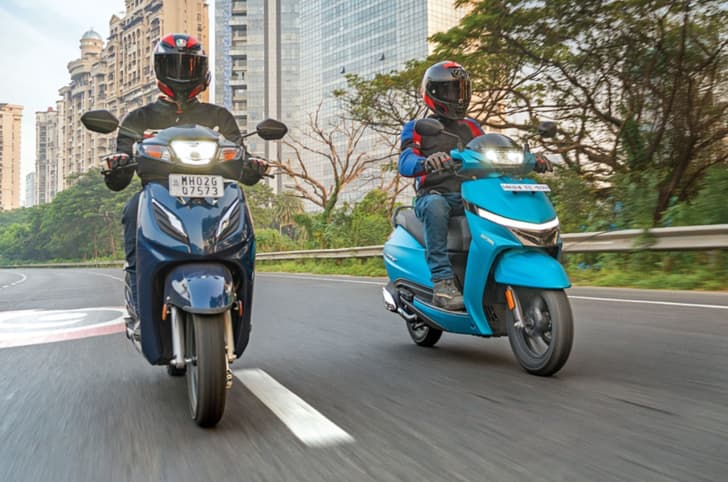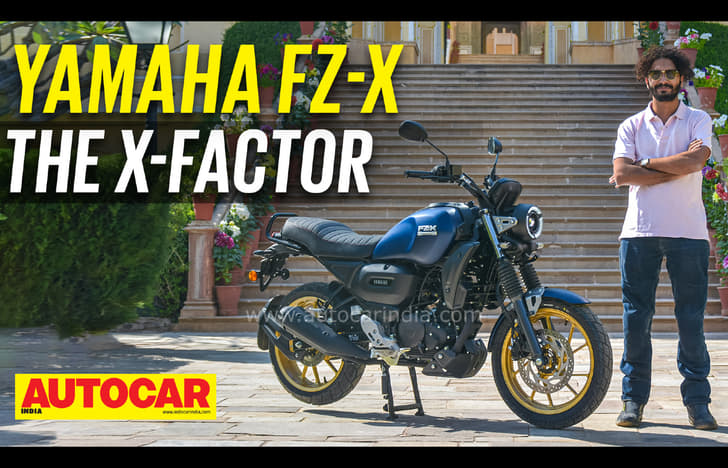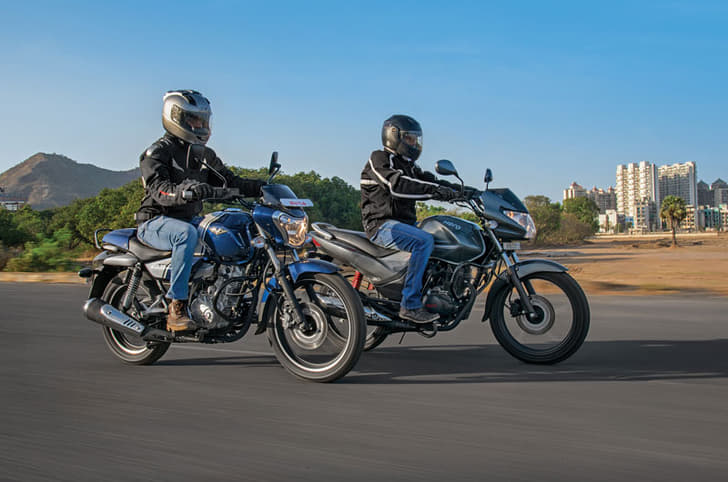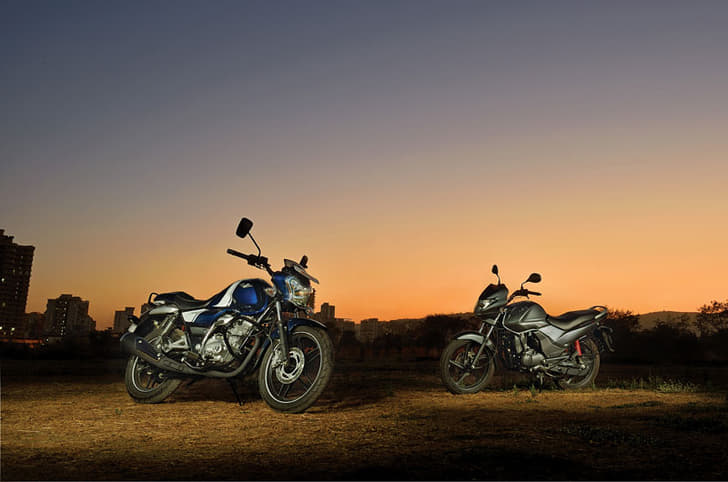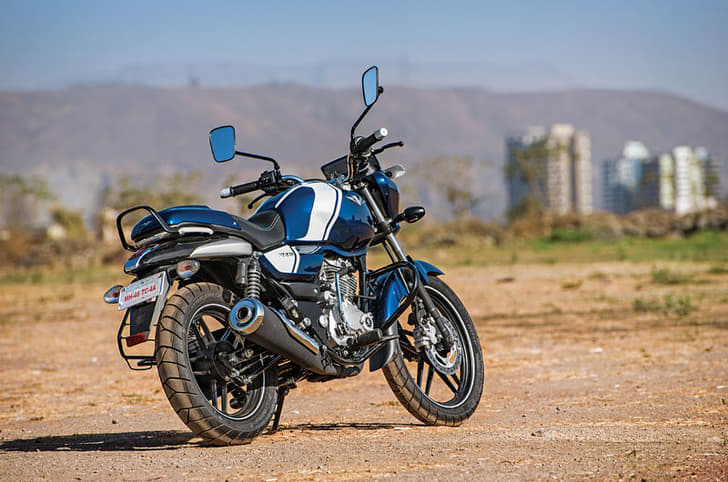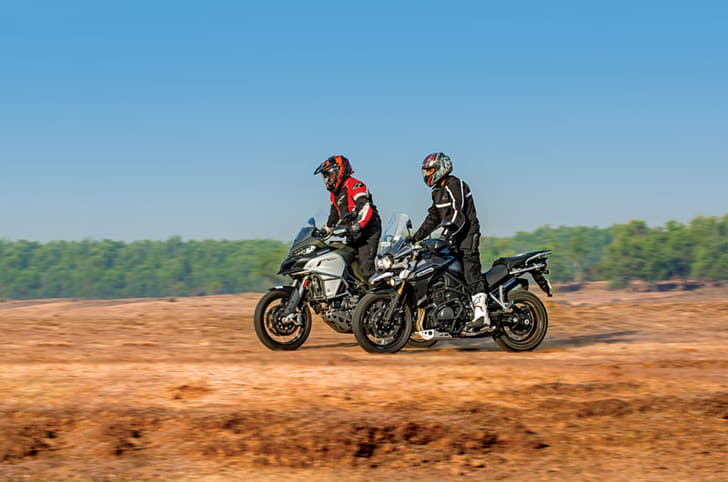After a six-month hiatus from riding motorcycles following a gnarly crash, I found myself gearing up to test two bonafide 100-plus hp roadsters: one, a bug-eyed oddity, but with a scorching resume – the fresh-off-the-stove Triumph Street Triple S – and the other, a mean, green, fighting machine – the Kawasaki Z900. Even at first glance, it’s clear that these two aren’t for novice riders and a look at their respective spec sheets certainly reaffirms that. “So,” I think to myself, “Is it a good idea to have these as my comeback motorcycles? Have I bitten off more than I can chew?”
Quirky and the beast
To be honest, what sparked my self-doubt is the Kawasaki. Though less angular as compared to its predecessor, the Z800, it still looks like one helluva brute. The headlights are similar to the older bike, but the bikini fairing around them is a lot curvier. But from the side, the lines of the low-set headlamp unit flow into the wide 17-litre fuel tank, which is now squatter, resulting in a wider impression overall. Under the tank, its four fat exhaust headers snake out of the chunky motor and duck under the bike before culminating into a stubby muffler on the right. The tail is even thinner than the Z800’s and rises higher, making it look much sharper than before. It does, however, maintain the distinctive LED tail-light from its precursor that seems to look like a ‘Z’. Plus, the green and black paint scheme on this bike looks absolutely wicked – it’s a proper thug, this! The other black/gray colour scheme is nowhere as wild as this one. It does, however, get the green painted trellis frame, which is a cool touch in itself.
This thug’s armour is not free from chinks, though. The tiny negative-LCD instrument cluster, while very informative, looks a bit too austere for a bike that is otherwise so menacing. And then you have the instrument cluster, which is functional, but looks like it belongs on a far less expensive motorcycle. No such problems for the Triumph Street Triple S. Sure, it doesn’t get the really high-tech, full-colour LCD instrument panel that the R and RS models get, instead choosing to stick with the tried and tested analogue/digital cluster from the previous Street Triple 675. But it has a few updates to its accents and still manages to look quite classy. The switchgear, too, maintains the familiar Triumph layout, and also features the 'Mode' button that we’ve seen on the latest generation of Bonnevilles.
This familiarity is the mantra of the new Street Triple’s design, and if one were to whizz by you, you’d be hard-pressed to differentiate it from the older bike. The tank is standard Street Triple fare and the remaining panels (though not as colourful anymore), including the little headlamp fairing, seem to have come from the previous Street Triple Rx. The biggest visual change has been the headlights. They’re still a twin-pod insectoid affair, but gone are the angular lights, replaced by the rounded ones from the new Speed Triple. A detailed observation reveals that the old asymmetric swingarm has made way for a new ‘gullwing’ swingarm, which is supposed to offer better handling characteristics. The underbelly exhaust has also seen a design change that makes it smaller, so the new swingarm can be viewed in its full glory. But then again, the tail and the tail-light seem to be lifted from the earlier Daytona-inspired Street Triple Rx as well. Overall, though, the design philosophy seems to have been “Why fix it if it ain’t broke?” So, while this new Triple looks quite attractive, it’s rather sedate and has nowhere close to the street presence of the Kawasaki.
Saddle speak
Hop on to the Z900 and it immediately strikes you just how comfortable the saddle is. It has a low seat height of 795mm but feels even lower than that for some reason. Getting both feet on the ground should be an easy task for most riders and manoeuvring the bike around with your feet while seated is a piece of cake. The handlebars are tall and wide, and within easy reach from the seat. There’s a slight lean forward to grab the bars, but nothing too aggressive. This lack of aggression is apparent in the footpeg position as well; they are sufficiently low set to create a rider’s triangle which leans towards comfort rather than sports riding. However, the tank rising tall in front of you creates an impression of riding a properly big motorcycle, although this Z isn’t anything larger than a mid-sizer. The tank does present one problem though – it’s a bit too wide and holding on to it with your thighs puts you in an odd ‘knees-out’ position.
The Street Triple’s tank, however, is much more slender and is naturally very conducive for holding on to with your thighs. It’s not too tall either, automatically making the bike feel smaller than it is, and affording that much more confidence when in the saddle. The one-piece seat of the old Street Triple has been swapped out for a two-piece unit, and the rider’s seat now is huge with enough space for even someone who’s ample-bottomed to move around in. The perch is a bit taller as well, but at 810mm, there’s no reason for it to alienate shorter riders. Higher placed footpegs and a slightly higher lean to reach the handlebars make for a sportier riding position than the Z. And the handlebars themselves are wider than those from the outgoing model, which used to feel unnaturally narrow for a street bike.
Healthier hearts
Both these bikes have received brand-new engines with increased cubic capacity when compared to their earlier generations. The new Street Triple S has a 765cc, inline-three cylinder motor which surprisingly isn’t an enlarged version of the earlier bike’s 675cc unit. It is, in fact, a bored and stroked version of the Daytona’s motor, which in the Street trim, makes 113hp along with 73Nm of torque. This is a significant increase, at least for India, as the Triumph only offered the 79hp version of the old Street Triple here. And the horsepower bump really shows. The motor has a healthy dose of mid-range torque and remains fairly punchy even as the revs climb. In outright acceleration, even on wet roads, the Street Triple S managed to do the run to 100kph from a standstill in just 3.97sec.
The Kawasaki’s motor hasn’t been derived from its predecessor either, and, in fact, is based on the Z1000’s larger powerplant. With a cubic capacity of 948cc and one extra cylinder than the Street Triple, it naturally makes more power – 125hp to be precise, coupled with 98.6Nm of torque. Both peak power and torque come in at lower rpm compared to the Triumph, and the stronger bottom-end performance is really noticeable. In fact, power delivery feels extremely linear, and there’s strong pull all the way to the motor’s redline. However, it does struggle to put all that power down, especially in the wet, owing to Kawasaki’s choice of shodding the Z900 with Dunlop Sportmax tyres. Zero to 100kph, as tested, was 4.15sec.
The Kawasaki also doesn’t feature a hint of electronic nannies for the motor. While purists might see this as a reason to celebrate, this might put off a lot of less experienced riders. And honestly, it’s rather surprising for a 125hp motorcycle launched in 2017 to not offer even basic traction control, considering the choice of tyres, which if we’re honest, barely keep up with the bike’s performance potential. Here the Triumph one-ups the Kawasaki. The change to a ride-by-wire throttle on the Street Triple has really made a huge change in the way the bike reacts to your right wrist’s inputs. Fuelling is super smooth, responsive and easy to modulate, and it has also allowed for a pair of riding modes – Road and Rain, the latter of which eases out the motor’s power delivery for riding in slippery road conditions. There’s also switchable traction control on offer, which unfortunately feels as basic as that from the new Bonneville family. On the few occasions, it cut in, the intervention was a rather abrupt cut in power. That being said, this safety net did bring some peace of mind while riding on rain-soaked roads during our test.
Overall gearing has also been shortened, which makes this Street Triple a lot easier to ride at slower speeds. But, to be honest, this is an area where the Z900 really comes into its own. The gearing feels even shorter than the Street Triple’s and paired with the bigger motor’s better bottom-end performance, you find yourself easily pottering around at speeds as low as 28-30kph in gears as high as fifth. In the urban crawl, the Z really is the new king and manages engine heat far better than the Triple as well. Even if you’re stuck in traffic, the Kawasaki vents heat away from the rider’s legs, while the Triumph rider has to contend with cooked legs, just like they would have to on most high capacity liquid-cooled multi-cylinder motorcycle. And just when we were starting to believe that the new Street Triple had one of the most refined engines in its class, the Z900’s motor completely blew our minds with how smooth it was. If we had to pick on motor alone, I think our choice would distinctly lean towards the big green machine.
Foot stomper or ballet dancer?
But the motor isn’t the only criterion on which these type of bikes are judged. And in matters of handling, the Z900 is no slouch. It gets a new trellis frame that’s a lot stiffer than the earlier tubular backbone frame from the Z800 and has shed over 20kg of overall weight as well, now weighing 208kg (wet). It retains the rebound and preload adjustable 41mm upside down front forks from the older bike, but they’ve been raked out from 24 degrees to 24.5 degrees now. The end result is a lighter and more agile motorcycle that hasn’t compromised on stability. However, there are some shortcomings, such as the aforementioned Dunlop tyres which are average at best. And the rear suspension setup (which is a linked monoshock) feels a bit off as well. It manages to feel soft and wallowy under hard cornering and seems a bit primitive with regards to its damping ability, which makes for a crashy ride over sharp bumps. Plus, the sitting posture, though very comfortable when just cruising around, doesn’t feel natural when cranking the bike over into a corner.
The Street Triple 765 is a masterclass of cornering performance – right from the perfect seating position to the way it feels when thrown around a twisty mountain road. A dry weight of 166kg makes it the lightest in its class, and it even weighs 2kg less than the older Street Triple. Triumph doesn’t disclose wet weight for their bikes but we reckon even with all the fluids in place, the Street Triple S will be a good 20kg lighter than the Z900. The front now gets separate function 41mm upside down forks while the rear gets a monoshock with a piggyback reservoir. Pitch it into a lean and the bike feels almost telepathic, and thanks to its Pirelli Rosso Corsa tyres, feels like it has endless amounts of grip. The suspension setup also works wonders on bad roads. The ride isn’t soft by any means, but rarely, if ever, any bumps seem to upset the Street Triple’s orientation, even if they are encountered mid-corner. The front forks don’t allow any adjustability, so forget about easily tuning the suspension for track use or something. But when the suspension works so well, you really won’t miss this adjustability, even for regular sport riding. Out on the twisties, the Z needs to be worked much harder and has a mighty tough time keeping up with the Street.
The one area where the two bikes are somewhat matched is braking, as neither of them gets radially mounted front calipers. The Street Triple gets twin 310mm floating discs at the front with Nissin two-piston sliding calipers and a Brembo single piston caliper biting a 220mm fixed disc at the rear. The Kawasaki’s brakes are an all Nissin affair with two 300mm petal rotors up front and a single 250mm petal rotor at the back. However, the front gets opposed four-piston calipers, giving the Z900 a slight advantage in terms of sheer stopping power. It’s able to pull to a dead stop from 80kph in just 26m. The Triple isn’t too far off but the feel at the lever, especially in initial travel, is slightly better than that of the Kawasaki’s.
Choosing time
Both the Kawasaki Z900 and the Triumph Street Triple S are great motorcycles, each appealing to a distinct set of riders. Those who value a comfortable riding position and practicality are really going to appreciate what the Z has to offer. Plus, it looks fantastic and there’s no way an inline-three is going to outsing the banshee wail from its four-cylinder motor. The Triple, however, is a corner carver’s delight. Its outright agility and confidence would even give more powerful motorcycles a run for their money out on real-world winding roads. While the Kawasaki feels like a brilliant street bike, the Triumph is a proper street-fighter – a sports bike sans fairing.
Had this comparison been done a short while back, the Street Triple would’ve won it by a mile. At pre-GST launch prices, the Triumph cost half a lakh rupees less than the Z900, as Kawasaki was only offering the bike with a whole bunch of mandatory accessories such as crash protectors and a taller flyscreen. Post-GST, however, Kawasaki pulled off a pricing masterstroke by launching the Z900 as a base model, without any of the earlier included accessories, at Rs 7.68 lakh (ex-showroom, pan-India). On the other hand, the new Triumph Street Triple S now costs Rs 8.71 lakh (ex-showroom, pan-India) – that’s over Rs 1 lakh dearer! One caveat regarding the Z900’s pricing is that some states such as Maharashtra levy much higher registration charges for imports (the Z900) as compared to CKDs (the Street Triple S), which leads to their on-road prices being a lot closer. However, regardless of the pricing difference, as it appeals to our inner sports bike rider a lot more, we’d still pick the Street Triple, but only by a whisker.





